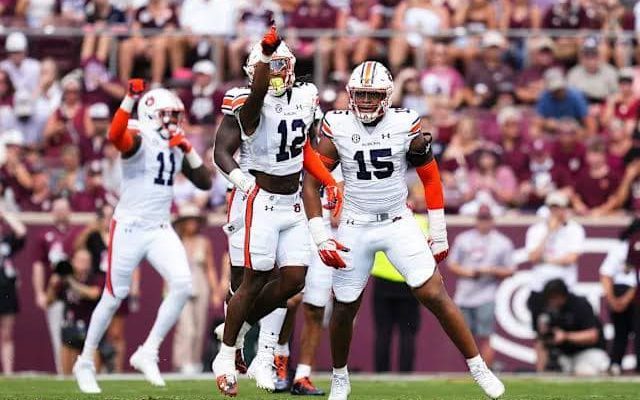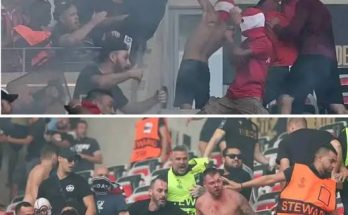’ : ’ — , ,
College football fans have grown accustomed to the summer months being a time of speculation, buzz, and in some cases, clarity. Summer depth charts drop. Position battles heat up. Coaches offer insight into progress, chemistry, and leadership. But for Auburn Tigers supporters, this summer brought something else entirely — a name missing from the roster, an absence without explanation, and a silence that has only deepened the mystery. One of Auburn’s most promising defensive players, who had previously been heralded as a linchpin of the Tigers’ up-and-coming unit, was quietly removed from the summer roster with no fanfare, no official release, and no details offered. No injury report was issued. No press conference from the coaching staff explained it away. And most puzzling of all, no one at Auburn seems willing to even acknowledge it happened.
The missing name? A player who had once been penciled in as a future SEC All-Conference talent. A name that defensive coordinator DJ Durkin once praised as “explosively instinctive” and “a guy who could quarterback the defense from multiple positions.” That kind of player doesn’t just vanish in mid-July without someone noticing — and yet, that’s exactly what appears to have occurred. Fans who scoured Auburn’s updated summer roster posted to the team’s website last week were quick to point out the omission. Social media accounts lit up with confusion. Message boards turned chaotic. Had he transferred? Was it disciplinary? A sudden personal decision? Was there an undisclosed health situation? The speculation spiraled in every direction, fueled by a complete absence of answers from Auburn’s administration or coaching staff.
The player in question had not only participated in spring camp but was reportedly thriving. Teammates and staff alike had noted his leadership during practices, his improved communication on the field, and his steady presence during team drills. There had been no whispers of discontent, no murmur of conflict, no signs of trouble academically or off the field. If anything, he was trending upward and quickly becoming a critical piece in the Tigers’ rebuilding efforts under Hugh Freeze. Which makes his sudden disappearance even more perplexing. There was no announcement. No social media post from the player thanking the university. No goodbye letter. No Instagram story suggesting he was “moving on to the next chapter.” Just a name, now gone.
This is not the first time Auburn has experienced an unexpected change to its roster, but rarely has one been this significant — or this quiet. The lack of transparency has drawn criticism from not only the fan base but also media observers. In today’s era of NIL, transfer portals, and real-time updates, it’s unusual for a Power Five program to remove a key player without providing context. Transparency isn’t just appreciated — it’s expected. And in Auburn’s case, the silence is especially loud because of what the player represented: potential, stability, and a symbol of the defensive turnaround that the Tigers have desperately sought for the last few seasons.
Auburn’s defense, historically known for producing NFL-caliber talent, has had its identity challenged in recent years. The post-Gus Malzahn era brought change, but not consistency. Defensive miscommunications, lapses in tackling, and an inability to close out games became painfully common. With the SEC’s offensive arms race intensifying, Auburn had made it a priority to rebuild its defense — both in the trenches and in the secondary. The missing player was part of that blueprint. Recruited as a four-star athlete with offers from LSU, Georgia, and Florida, he was the kind of signing Auburn needed to keep pace with its rivals. More than that, he was a culture guy — someone coaches pointed to in film sessions, someone who understood schemes at a high level, someone whose motor never stopped. He had been cross-trained at both linebacker and safety, and was expected to be deployed as a hybrid weapon against modern spread offenses. His football IQ was advanced. His role was versatile. And now, his status is unknown.
Without clarification from Auburn, rumors have begun to fill the void. Some insiders suggest an off-the-field issue, while others hint at a potential medical concern. There’s talk of a possible quiet suspension or an internal team matter being handled “in-house.” But these remain just that — rumors. And in the absence of facts, the story takes on a life of its own. For a team looking to regain national relevance and project stability under Freeze, that’s a dangerous narrative to allow unchecked. Even if the decision to remove the player from the roster was made in good faith — for personal, disciplinary, or medical reasons — the optics of radio silence can’t be ignored. It creates a vacuum. It breeds distrust. It allows conjecture to dominate instead of truth.
The timing is also significant. Auburn is entering a crucial stretch. The Tigers are just weeks away from fall camp, where position battles will define the season’s trajectory. Every rep counts. Every player matters. And every leadership voice in the locker room is critical. Removing a key contributor this late in the offseason without a known plan to replace his production puts additional pressure on a defense that still lacks depth in certain areas. Younger players may be thrust into roles they’re not ready for. Transfers may need to accelerate their learning curves. Chemistry and trust — things that take months to build — could be affected in subtle but real ways. In a league like the SEC, where inches determine championships, even the smallest disturbance can ripple into something bigger.
There is also a recruiting component to consider. Prospects and their families pay attention to how programs treat their players — especially when it comes to handling departures or difficult situations. A high-profile player disappearing without acknowledgment raises questions. Was he treated fairly? Did he leave on good terms? Was he supported through whatever challenges may have emerged? These are the kinds of questions that matter to parents of recruits, and Auburn’s silence, however well-intentioned, may inadvertently cast doubt where clarity is most needed.
Behind the scenes, it’s possible that Auburn is simply respecting the privacy of the student-athlete, especially if personal or medical issues are involved. That would be both admirable and appropriate. But in such cases, schools often issue a general statement — something that acknowledges the absence without going into specifics. A message of support. A commitment to the player’s wellbeing. Anything that shows the program has the player’s back, even if he’s stepping away. The fact that Auburn has not done so — at least publicly — has only added to the confusion.
There is also the matter of leadership. Coach Hugh Freeze has made culture-building a priority since arriving at Auburn. He’s spoken about accountability, character, and communication. He has emphasized honesty and openness as core principles of his program. This situation, though perhaps complicated behind the scenes, does not align with that ethos in the eyes of many fans. Freeze has a reputation for being candid, and while he doesn’t owe the media a tell-all in every circumstance, his unwillingness to address the situation — even with a general acknowledgement — is beginning to create a rift between expectations and reality.
It’s not just fans and media who notice. Within the locker room, players are well aware of who is there and who is not. The sudden loss of a teammate — especially one with status and talent — leaves a hole emotionally as much as physically. These young men forge bonds in the weight room, in film sessions, on road trips, and through adversity. The sudden disappearance of one of their own, without an explanation or chance to process, could affect team morale in subtle but lasting ways. Leadership isn’t just about schemes and gameplans; it’s about how programs treat their people.
As the Tigers gear up for fall practices and the inevitable intensity of the SEC schedule, they will do so with this cloud hanging over their preparation. Every press conference, every media availability, and every fan Q&A will likely feature some version of the same question: “What happened to him?” If Auburn continues to deflect or ignore the issue, it risks allowing this single storyline to overshadow everything else — including legitimate progress elsewhere on the roster. And that would be a shame, because there has been progress. Young players are developing. Coaches are settling into their roles. The new strength and conditioning program is earning praise. The team is showing signs of a cultural reboot. But none of that will matter if the public’s attention remains fixated on what Auburn refuses to talk about.
For a program that sits at a delicate crossroads — caught between rebuilding and relevance, tradition and transformation — moments like this one matter. They’re litmus tests for leadership. They reveal whether a program can handle adversity with grace and communication. They speak volumes about a team’s internal alignment and trust with its community. And in this instance, Auburn has fallen short of the transparency many hoped for.
Maybe there’s a good reason the player left the roster. Maybe it was mutual. Maybe he’ll reappear at another school. Maybe he’ll speak his truth in time. But until that moment comes, Auburn is left with a mystery — one that grows louder the longer it is ignored. College football thrives on narratives. And right now, the story surrounding this missing player is a cautionary one about silence, uncertainty, and the price of unanswered questions.



